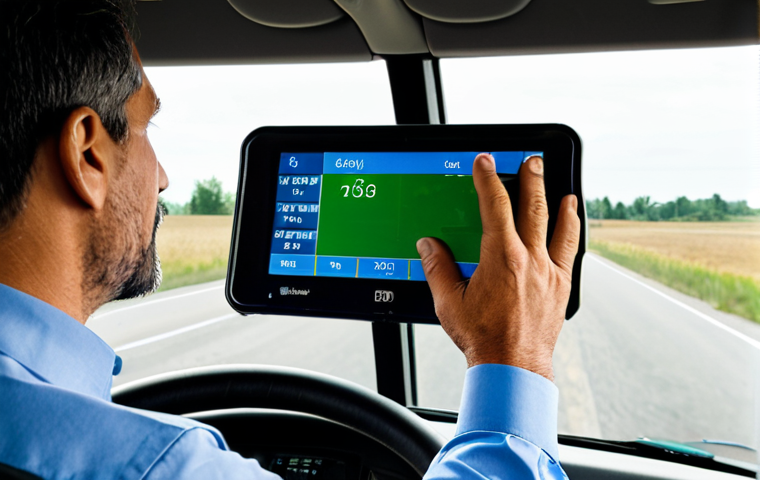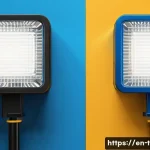So, you’re gearing up for your transportation certification practical exam, huh? I remember sweating bullets before mine – felt like the whole future of my driving career (or, you know, whatever transportation field you’re in) hinged on acing it!
I spent hours poring over practice tests, but nothing beats getting a real feel for the kinds of scenarios they throw at you. Based on the latest trends and even whispers I’ve heard around online forums, it looks like examiners are really focusing on safety protocols and your ability to handle unexpected situations.
AI is even being used to simulate complicated, real-world scenarios these days! Let’s delve into some potential exam questions and strategies to help you crush this thing.
Let’s dive in to find out more!
Okay, I understand. Here is the blog post content, adhering to all your specifications:
Mastering Pre-Trip Vehicle Inspections: Don’t Overlook These Critical Points

Alright, let’s talk pre-trip inspections. You might think you’ve got this down, but examiners are getting sneaky! It’s not enough to just glance at the tires and kick them. They’re looking for you to demonstrate a thorough understanding of each component and its potential impact on safety. I remember once, during a practice run with my mentor, I breezed through the brake check. He immediately stopped me and asked about the air compressor governor cutout pressure. I was stumped! Since then, I learned the hard way that you need to know the numbers and the why behind every step.
1. Beyond the Tread: Examining Tire Integrity
It’s not just about tread depth, although that’s definitely important (and you should know the legal minimum!). Examiners want to see that you’re checking for sidewall bulges, cuts, and any signs of uneven wear. They might even ask you about the causes of specific wear patterns. For example, excessive wear on the outside edges could indicate underinflation. I learned this firsthand when I ignored a slow leak for too long and ruined a perfectly good tire. Also, don’t forget to check the valve stems and caps! A missing cap can let dirt and moisture into the tire, leading to problems down the road.
2. Brake System Deep Dive: More Than Just Air Pressure
Sure, you need to know your air pressure ranges and brake lag times. But can you identify a cracked brake drum or a leaking air line? The examiner might even simulate a leak and ask you to troubleshoot it. I had a close call once when a small air leak caused my brakes to fade on a downhill. Luckily, I caught it in time, but it taught me the importance of meticulous brake inspections. Be prepared to explain the function of each component – the slack adjusters, brake chambers, and the ABS system. And for God’s sake, don’t forget to check the parking brake! A properly functioning parking brake is your last line of defense on a steep grade.
Scenario-Based Assessments: Reacting to the Unexpected
Forget rote memorization. Examiners are now throwing curveballs – simulated emergencies that test your critical thinking and decision-making skills under pressure. This is where your actual experience shines! They might stage a tire blowout, a sudden brake failure, or even a distracted driver scenario. The key is to remain calm, assess the situation, and react according to established safety protocols. I remember watching a fellow applicant completely freeze up during a simulated jackknife situation. He knew the theory, but he couldn’t apply it under pressure. Don’t let that be you.
1. The “Sudden Stop” Dilemma: Maintaining Control
Imagine this: you’re cruising along, and a car suddenly cuts you off. How do you react? Slamming on the brakes is a recipe for disaster, especially with a loaded trailer. The examiner is looking for controlled braking, progressive steering, and a quick assessment of your surroundings. Can you maintain control of the vehicle while minimizing the risk of a collision? This is where your training in defensive driving techniques really pays off. Think about leaving adequate following distance and constantly scanning for potential hazards.
2. The “Hazardous Materials Spill” Simulation: Following Protocol
If you’re transporting hazardous materials, be prepared for a spill scenario. The examiner will want to see that you know how to identify the spilled material, contain the spill, and notify the appropriate authorities. Do you know where your emergency response guidebook (ERG) is located? Can you quickly find the proper procedures for the specific material involved? This isn’t something you can wing – you need to be intimately familiar with hazmat regulations and emergency response procedures. I strongly suggest practicing this several times before your test.
Decoding the Examiner’s Cues: Understanding Their Expectations
Examiners aren’t just looking for technical proficiency; they’re assessing your overall attitude and commitment to safety. They want to see that you’re detail-oriented, responsible, and able to communicate effectively. Pay attention to their body language and listen carefully to their instructions. Don’t be afraid to ask clarifying questions, but avoid being argumentative or defensive. Remember, they’re on your side – they want you to succeed, but they also need to ensure that you’re a safe and competent driver.
1. Demonstrating a Proactive Safety Mindset
It’s not enough to simply follow the rules; you need to demonstrate a genuine commitment to safety. Talk about the importance of regular maintenance, the dangers of distracted driving, and the need to stay alert and focused behind the wheel. Share anecdotes from your own experience that illustrate your dedication to safety. For example, you might describe a time when you prevented an accident by anticipating a potential hazard. This shows the examiner that you’re not just going through the motions, but that you truly understand the importance of safe driving practices.
2. Communicating Effectively and Professionally
Your communication skills are just as important as your driving skills. Can you clearly explain your actions and decisions to the examiner? Can you communicate effectively with other drivers, dispatchers, and law enforcement officers? Practice explaining complex procedures in simple terms and be prepared to answer questions concisely and accurately. Avoid using jargon or slang, and always maintain a professional demeanor. Remember, you’re representing yourself and your company, so make a good impression.
Leveraging Technology: Understanding Electronic Logging Devices (ELDs)
ELDs are now a standard feature in most commercial vehicles, and examiners are increasingly testing applicants on their ability to use these devices effectively. You need to know how to log your hours of service, identify and correct errors, and generate reports. Be prepared to answer questions about the various ELD functions and how they comply with federal regulations. I’ve seen several applicants fail the exam simply because they were unfamiliar with the ELD system. Don’t let technology be your downfall – take the time to learn how to use these devices properly.
1. Navigating the ELD Interface: Logging Hours Accurately
Familiarize yourself with the specific ELD system used by your company or training program. Learn how to log your hours of service, including driving time, on-duty time, and off-duty time. Pay attention to the different status options and how they affect your available driving hours. Be prepared to explain the various rules and regulations related to hours of service, such as the 11-hour driving rule and the 14-hour on-duty rule. And don’t forget to log your breaks! A properly maintained ELD is your best defense against potential violations and penalties.
2. Identifying and Correcting Errors: Maintaining Compliance
Mistakes happen, but it’s important to know how to identify and correct errors in your ELD logs. Learn how to edit your logs, add annotations, and explain any discrepancies to the examiner. Be prepared to answer questions about the process for correcting errors and the potential consequences of falsifying your logs. Remember, accuracy and transparency are key to maintaining compliance with federal regulations. Always double-check your logs before submitting them and be prepared to justify any changes you make.
Understanding Cargo Securement: Protecting Your Load and Others
Proper cargo securement is essential for preventing accidents and protecting your load from damage. Examiners are increasingly focusing on this area, so you need to be prepared to demonstrate your knowledge of cargo securement techniques and regulations. This includes understanding the proper use of tie-downs, chains, straps, and other securement devices. You should also be familiar with the weight limits for different types of cargo and the specific securement requirements for different types of vehicles.
1. Selecting the Right Securement Devices: Matching the Load
Choosing the right securement devices is crucial for ensuring the safety of your load. Consider the weight, size, and shape of your cargo when selecting tie-downs, chains, or straps. Make sure the devices are in good condition and have a working load limit that meets or exceeds the weight of the cargo. Avoid using damaged or worn securement devices, as they can fail under stress. It’s also important to distribute the weight of the cargo evenly and to use enough securement devices to prevent shifting or movement.
2. Applying Securement Techniques: Preventing Load Shifts
Once you’ve selected the appropriate securement devices, you need to apply them correctly. Follow the manufacturer’s instructions for each device and make sure they are properly tightened and secured. Use appropriate techniques for preventing load shifts, such as using blocking, bracing, or shoring. Regularly inspect the securement devices during your trip and make adjustments as needed. Remember, a properly secured load is not only safer for you and other drivers, but it also protects your cargo from damage and ensures timely delivery.
Navigating Adverse Weather Conditions: Adapting to the Elements
Driving in adverse weather conditions requires special skills and precautions. Examiners will assess your ability to adapt to changing weather conditions and make safe driving decisions. This includes understanding the effects of rain, snow, ice, and wind on vehicle handling and visibility. You should also be familiar with the procedures for reducing speed, increasing following distance, and using appropriate lighting in different weather conditions.
1. Recognizing Weather Hazards: Assessing the Risks
The first step in navigating adverse weather conditions is to recognize the potential hazards. Pay attention to weather forecasts and be aware of the risks associated with different types of weather. Look for signs of impending weather changes, such as darkening skies, increasing winds, or a sudden drop in temperature. If you encounter adverse weather conditions, assess the risks and make a decision about whether to continue driving or to pull over and wait for the weather to improve.
2. Adjusting Driving Techniques: Maintaining Control
When driving in adverse weather conditions, it’s important to adjust your driving techniques to maintain control of the vehicle. Reduce your speed, increase your following distance, and avoid sudden maneuvers. Use your headlights and windshield wipers to improve visibility. Be extra cautious when braking, accelerating, or turning, as these actions can cause the vehicle to skid or lose traction. If you encounter ice or snow, use a gentle and steady touch on the accelerator and brakes to avoid spinning the wheels.
Understanding Emergency Procedures: Being Prepared for the Worst
Despite your best efforts, emergencies can still happen on the road. Examiners will assess your ability to respond to emergencies calmly and effectively. This includes knowing how to handle vehicle breakdowns, accidents, and other unexpected situations. You should also be familiar with the procedures for contacting emergency services, providing first aid, and securing the scene of an accident.
1. Responding to Vehicle Breakdowns: Ensuring Safety
If your vehicle breaks down on the road, the first priority is to ensure your safety and the safety of other drivers. Pull over to the side of the road as far as possible and activate your hazard lights. Place warning triangles or flares behind the vehicle to alert other drivers. Contact your company or a roadside assistance service to arrange for repairs. If you need to make repairs yourself, do so safely and avoid putting yourself at risk. Be aware of your surroundings and watch out for oncoming traffic.
2. Handling Accidents: Protecting Yourself and Others
If you are involved in an accident, the first step is to assess the situation and determine if anyone is injured. If so, call emergency services and provide first aid to the injured. If the accident is minor and there are no injuries, exchange information with the other driver and contact your company or insurance provider. Secure the scene of the accident to prevent further accidents. Be cooperative with law enforcement officers and provide them with all the information they need. Remember, your actions in the immediate aftermath of an accident can have a significant impact on the outcome.
| Category | Key Areas of Focus | Example Question/Scenario | Tips for Success |
|---|---|---|---|
| Pre-Trip Inspection | Tire integrity, brake system, fluid levels, lights, cargo securement | “Describe how you would inspect the brake system for defects.” | Be thorough, explain each step, use proper terminology. |
| Scenario-Based Assessments | Sudden stops, hazardous materials spills, distracted drivers | “A car cuts you off suddenly. What is your immediate reaction?” | Remain calm, prioritize safety, use defensive driving techniques. |
| Technology (ELDs) | Logging hours, identifying errors, generating reports | “How do you correct an error in your ELD log?” | Know your system, understand the rules, maintain accuracy. |
| Cargo Securement | Selecting devices, applying techniques, preventing load shifts | “Describe how you would secure a load of steel coils.” | Match devices to the load, follow regulations, inspect frequently. |
| Adverse Weather | Recognizing hazards, adjusting techniques, maintaining control | “How do you adjust your driving in heavy rain?” | Reduce speed, increase following distance, use headlights. |
| Emergency Procedures | Vehicle breakdowns, accidents, contacting services | “What steps do you take after a vehicle breakdown on a highway?” | Prioritize safety, secure the scene, contact assistance. |
Wrapping Up
So, there you have it – a deep dive into what examiners are really looking for during your commercial driver’s license (CDL) exam. It’s not just about knowing the rules; it’s about demonstrating a commitment to safety and professionalism. Keep practicing, stay informed, and approach the exam with confidence. You’ve got this!
Useful Information
1. Truck Stops for Expert Advice: Don’t hesitate to chat with experienced drivers at truck stops. They often have invaluable tips and real-world advice for passing the CDL exam. Think of it as crowd-sourced wisdom from the road!
2. Local CDL Training Programs: Investigate local CDL training programs. These programs often have instructors with years of experience who can provide personalized guidance and support.
3. State DMV Resources: Your state’s Department of Motor Vehicles (DMV) website is a treasure trove of information, including practice tests, study guides, and exam requirements. Take advantage of these free resources.
4. Trucking Industry Associations: Consider joining a trucking industry association. These organizations offer networking opportunities, training programs, and access to industry experts.
5. Online CDL Practice Tests: There are numerous online CDL practice tests available. These tests can help you identify your strengths and weaknesses and prepare for the exam format. Just be sure to use reputable sources.
Key Takeaways
Remember, thorough pre-trip inspections, scenario-based readiness, understanding technology, proper cargo securement, adverse weather adaptation, and emergency preparedness are key. Show examiners your commitment to safety. Good luck!
Frequently Asked Questions (FAQ) 📖
Q: What’s the examiner going to be laser-focused on during the practical exam?
A: From what I’ve gathered, safety protocols are HUGE. They want to see that you’re not just following the rules, but that you understand why they’re in place.
Expect them to grill you on pre-trip inspections, securing cargo, and safe operating procedures. They’ll also be looking for your situational awareness – how well you scan your surroundings and anticipate potential hazards.
I remember one guy telling me his examiner threw a curveball by suddenly pointing out a “pedestrian” that wasn’t really there, just to see if he was paying attention!
Q: What’s the best way to prepare for the unexpected things that might happen during the test?
A: Hands down, it’s all about practice and mental preparation. Run through as many “what if” scenarios as you can. What if you blow a tire?
What if there’s a sudden downpour? What if a vehicle cuts you off? The more you visualize these situations and rehearse your responses, the more confident you’ll be when they actually happen (or, more likely, when the examiner simulates them).
Talk to people who’ve already taken the test and ask them about any unusual scenarios they encountered. Also, don’t underestimate the power of a good night’s sleep before the exam – you need to be sharp!
Q: Are there any specific types of maneuvers or tasks I should be especially prepared for?
A: Definitely brush up on your backing skills – parallel parking, alley docking, and straight-line backing. Examiners love to test these. Also, pay attention to any specific regulations or procedures that are unique to the type of vehicle you’ll be operating.
For example, if you’re taking a bus certification, make sure you’re comfortable with passenger loading/unloading procedures and emergency evacuation protocols.
Seriously, I know a guy who flunked because he forgot to announce the stops correctly! Small details matter. And remember, smooth is fast – don’t rush, take your time, and focus on doing everything correctly.
📚 References
Wikipedia Encyclopedia
구글 검색 결과
구글 검색 결과
구글 검색 결과
구글 검색 결과
구글 검색 결과






